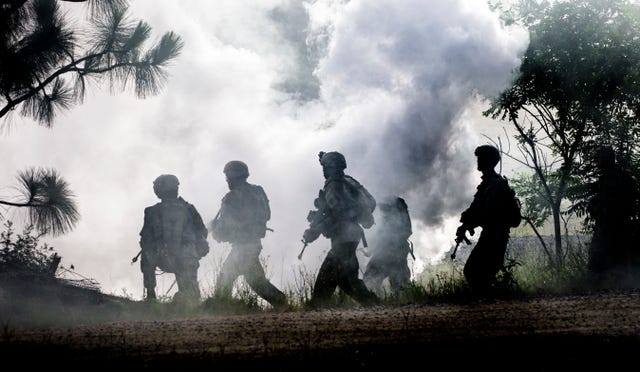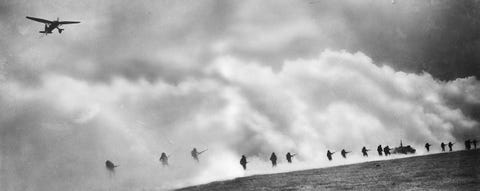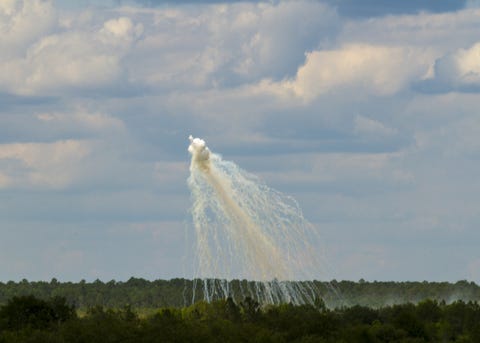KYLE MIZOKAMI

The Pentagon’s mad scientist division is working on a fresh replacement for an old tool on the battlefield: smoke. The Defense Advanced Research Projects Agency (DARPA) is leading an effort to develop a new smoke-like obscurant that will prevent enemy troops from seeing through it. The twist will be that while the new smoke blocks adversaries’ vision, it will still allow U.S. and allied forces to see the entire battlefield.
✈︎ Don’t miss any of our best-in-class military and defense coverage. Join our squad.
One of the most useful tools in the history of warfare is smoke. Dense, billowy clouds of smoke, created by burning wood and other flammable materials, block lines of sight across the battlefield—for both sides. In the past, that might have involved using smoke pots to prevent militia defending castles from seeing approaching siege weapons, or artillery shells crashing down on the battlefield, preventing defending infantry from seeing advancing tanks.

British Army troops emerge from a smoke screen during training, 1947.
GEORGE W. HALESGETTY IMAGES
The problem is that smoke worked against both sides. Military forces often treat smoke as temporary terrain, blocking vision just as surely as a mountain or a wall of trees. While smoke eventually subsides, it can both hinder and help attackers or defenders equally.
In the 1980s, technology finally intervened to give one side an advantage: the use of thermal night sights, which US and NATO forces used to see and shoot through smoke. Soviet and Warsaw Pact troops used more primitive forms of night vision. This conferred an enormous advantage on US and NATO troops, who could now observe and fire on enemy forces that were effectively operating blind.
Today, most modern armies have thermal night vision, leveling the playing field. DARPA wants that advantage back, so it’s working on what it calls Coded Visibility, which “aims to develop tailorable, tunable, safe obscurants that provide warfighters with an asymmetric advantage, enhancing friendly forces’ visibility while suppressing adversary vision and detection systems,” according to DARPA’s news release.

This illustration by DARPA shows a friendly soldier on the left able to see through a Coded Visibility screen, observing the soldier on the right.
DARPA
DARPA will explore Coded Visibility using two approaches: passive and active asymmetry. Passive asymmetry, program manager Rohith Chandrasekar says in the release, “will likely require multiple obscurant materials deployed in specific ways to allow one-way vision through the plume.” Obscurants could include smoke, a liquid aerosol spray, or could even mean something more exotic, like metamaterials—engineered composites designed to interact with electromagnetic radiation for certain purposes. In this case, a cloud of metamaterials could be used to block light, or allow it to enter only from certain angles.
DIVE DEEPER INTO MILITARY TECH STORIES WITH US
On the other hand, active asymmetry will require “a single obscurant material, but one that can be tuned in real time” to let troops see through it, Chandrasekar says. Friendly troops might be able to control a curtain of active asymmetry smoke, by turning on—or off—the ability to see through it with night vision or similar means. Sometimes, it might be preferable to block everyone from seeing through coded visibility “smoke,” if enemy troops gain this ability too.

A white phosphorus round air burst over targets during the 3rd Combat Aviation Brigade’s Joint Air Attack Team on Fort Stewart May 22.
PHOTO BY SPC. SCOTT LINDBLOM, 3RD CAB PUBLIC AFFAIRS/DVIDS
Coded Visibility will also need to be safe for humans to breathe. The U.S. military currently uses white phosphorus to create smoke screens. The problem is that white phosphorus (WP) is pyrophoric, meaning it burns upon contact with air, and as such is extremely hazardous to be around. U.S. troops are trained to use WP to minimise the danger to themselves, but its use on the battlefield can expose troops to charges of endangering civilians. In 2017, Human Rights Watch warned that US-led forces fighting ISIS in Iraq and Syria were using WP, risking harm to civilians. Ideally, troops and civilians could walk unprotected through Coded Visibility screens, emerging unharmed.
DARPA’s project is ambitious, but it could have limited utility in the end. If adversaries can hack a tuneable smoke screen, they could turn the tables on friendly forces, making the screen opaque at critical moments. An adversary could also block the good guys with a Coded Visibility screen of their own. We could be seeing the beginning of a smoke screen arms race, with each military racing to ensure that its side—and its side alone—has an unrestricted view of the battlefield.
No comments:
Post a Comment